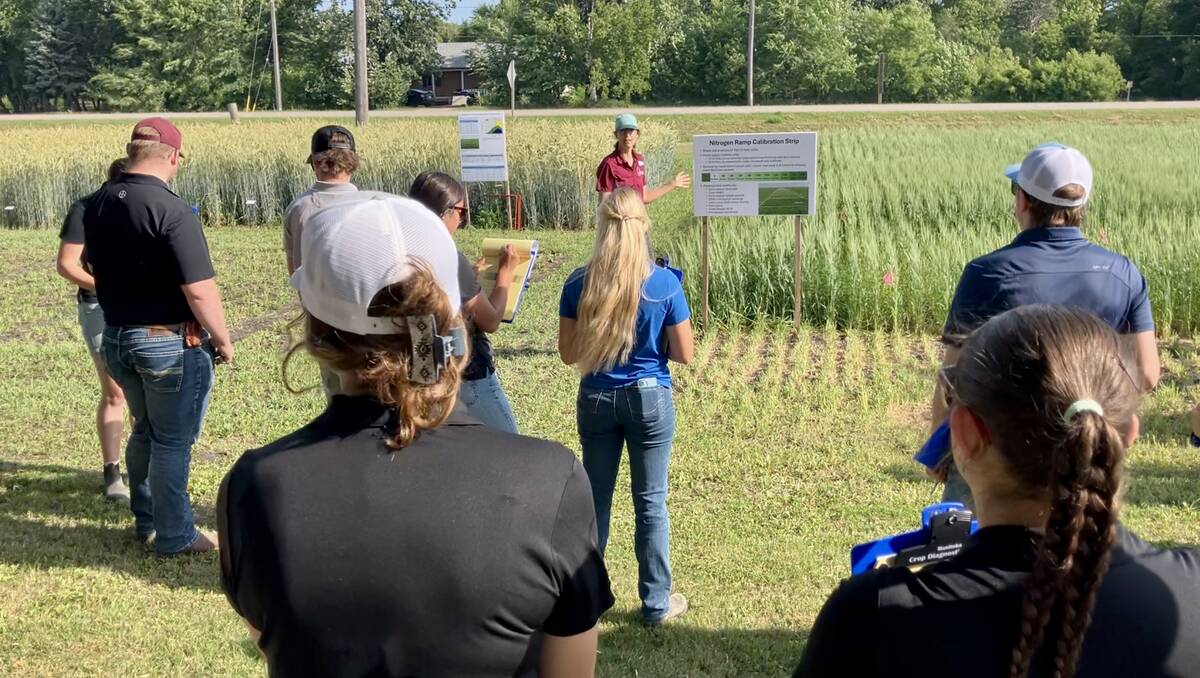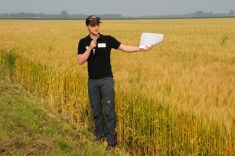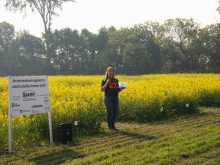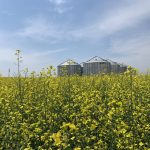Manitoba farmers might be spending more on fertilizer and seed than they need to, according to new research from the Manitoba Canola Growers Association.
Results from the association’s 2024 on-farm research suggests that increasing nitrogen rates, at least last year, might not have boosted canola yields and that adjusting seeding rates based on plant populations can significantly improve efficiency and profitability.
Why it matters: On-farm research takes agronomy and the evaluation of farm practices out of the academic arena and shows how things play out under real field and real farm conditions.
Read Also

Ramp up your nitrogen efficiency in winter cereals: VIDEO
Nitrogen ramps are a tool to help farmers hone their fertilizer rate for the best, most cost efficient winter wheat or fall rye crop.
The program, which started in 2022, aims to provide farmers with practical and science-backed recommendations to improve profitability and sustainability. It has looked at nitrogen rates, seeding rates and phosphorus source trials at 37 locations across the province.
“The main goals of our on-farm research program is to provide applied, easily transferable results to Manitoba farmers by bringing farmers into the research process and evaluating new or improved production practices across a wide range of farm operations in Manitoba,” said Amy Delaquis, a research and agronomy manager with the Manitoba Canola Growers Association (MCGA) via e-mail.
Nitrogen rate trials in 2024 set out treatments at 75, 100, and 125 per cent of standard rates and then measured the resulting yield and nitrogen use efficiency. Yields ranged generally from 42 to 58 bushels per acre, but differing N rates did not translate to significant difference in yield. Nitrogen use per bushel averaged 3.8 pounds, with a wide range of 2.1 to 7.1 pounds.
“Because grain yield was not significantly increased when N rates increased, as the amount of N fertilizer supplied to the crop increased the efficiency of N was reduced,” the report read. “This would have reduced economic returns as more N fertilizer was used to produce similar grain yield.”
Past research has looked a little different, Delaquis said.
“We definitely had trials in 2022 and 2023 that saw a yield increase from increased N fertilizer rates, but in 2024, it seemed like the story was more about disease pressure than nitrogen. We saw a lot of blackleg/verticillium wilt onset late in the season that was likely limiting yield in a lot of our trials.”
The most important advice Delaquis has for producers is to set a realistic yield goal for fields and fertilize appropriately, staying in canola’s 2.5 to 3.5 pounds of nitrogen per bushel of target yield for Manitoba.
“With that, farmers need to account for factors that may be reducing nitrogen availability to the crop, including application sources, timing and placement,” Delaquis said.
Other considerations include mineralization potential.
How much seed in the ground?
Seeding rate trials examined whether adjusting rates could optimize plant establishment, emergence and grain yield. Across six trial sites, results varied depending on local conditions and practices.
Four of the six farms were already pushing the envelope on low seeding rate. At the two with the lowest (a standard seeding rate of only two pounds an acre), plant populations saw between 3.1-3.4 plants per square foot on the standard treatment, and bumping the seeding rate up by 0.5-0.7 pounds an acre did increase the final yield.
In contrast, sites that were seeding more heavily (3.9 and 4.2 pounds an acre as standard) saw that translated into seven to 9.5 plants a square foot, over the recommended five plants per foot recommendation. In those cases, cutting seeding rate led to leaner plant stands and more total yield.
The data suggests that some farmers might, within reason, be able to cut their seeding rates without hurting their profit margin. From 2022-2024, the association noted, a 25 per cent reduction in seeding rate has also meant 13 per cent greater emergence, while bolstering seeding rates by 25 per cent on average means four per cent fewer canola plants will break ground.
The ideal plant population of canola is five to eight plats per square foot, Delaquis said. Within that range, the crop capitalizes on resources while still having good competitive ability against crop pests.
It’s important for producers to understand their farm’s emergence percentage, she added. It can vary greatly with different seeding equipment, fertilizer management and soil types.
“We also clearly saw in these trials that emergence per cent was greatly influenced by seeding rate. So, as seeding rates were reduced, there was an increase in emergence per cent due to reduced competition within row. So, it’s important to understand your current emergence per cent but also how that will change with management such as seeding rate changes. There may be opportunity to reduce input costs by lowering seeding rates without seeing much of a reduction in plant stand.”
Phosphorus
In a new addition to the lineup this year, phosphorus source trials evaluated the effects of different fertilizer types on phosphorus availability, plant safety and yield.
Farms chose two phosphorus sources, both of which were tested at a standard and heightened rate. No significant differences were observed in plant establishment or tissue phosphorus concentrations across treatments. There were some top performing fertilizer sources when it came to yield, but researchers strongly cautioned that, with only one year of data under their belt on the trial, results should be taken with a grain of salt
“This is the first year of these trials and this year was about understanding what that most valuable data was to get out of these trials,” Delaquis said. “Because phosphorous availability is so dependent on the soil conditions – less available in cool, wet soils – it is very important to continue these trials and see how some of these products perform across different conditions,” Delaquis said.
Other research
The research program also included studies on seed-placed fertilizer toxicity and cover cropping for flea beetle management. Early findings from seed-placed fertilizer trials indicated that wet spring conditions in 2024 allowed canola to tolerate higher-than-recommended rates of fertilizer with minimal impact on emergence. However, farms using nitrogen, phosphorus, or sulfur rates exceeding safe levels showed reduced emergence when soil moisture levels were low to medium at seeding.
A collaborative cover cropping trial conducted with the University of Manitoba explored the use of spring-planted cereal nurse crops to reduce flea beetle damage in canola.
The 2024 results are preliminary and part of ongoing research to refine recommendations for Manitoba canola producers, Delaquis said. The program is set to continue into the 2025 growing season, with additional trials and expanded data collection to build on 2024’s findings.
Into the New Year
Some of this year’s trials will likely focus on disease management for canola, particularly for verticillium stripe, Delaquis said.
“Our research committee that is made of farmers from across Manitoba provide direction on what the major issues that our on-farm research program should be focusing on. We try to stay as close to the farm level as possible and ensure that we are testing treatments that farmers can take and implement on their farms relatively quickly.”
Producers interested in learning more or participating in the trials are encouraged to contact the association, Delaquis added.
“We are always open to discussions around new trial types and research questions that could be included in our on-farm research program.”




















